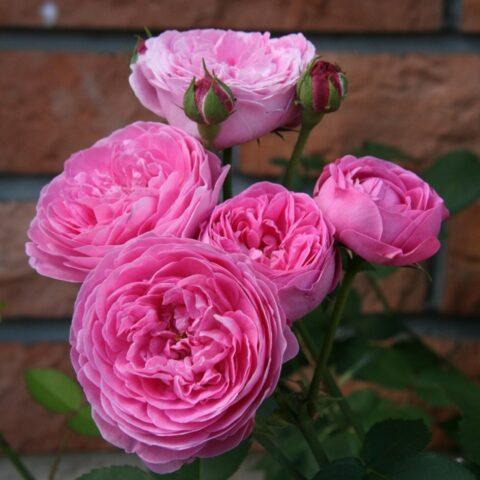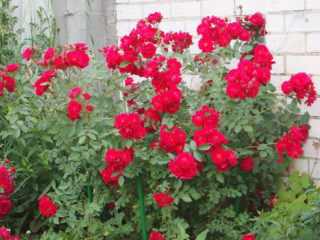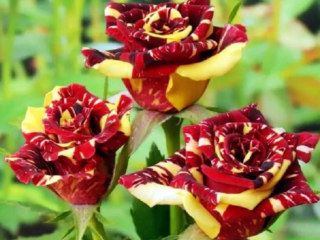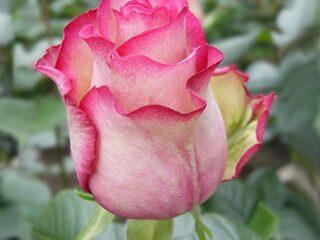Content
Park rose Louis Odier is a worthy representative of the magnificent Bourbon group. Thanks to its rich history and excellent characteristics, the popularity of the variety does not fall; gardeners still prefer it. If you follow the rules of agricultural technology and plant care, magnificent flowering can be observed some time after planting.

The park rose loves to grow in freedom; it needs space and reliable support.
History of selection
It is believed that the park rose is the result of the work of breeder James Odier, who worked on its breeding in the Bellevue nursery, located on the left bank of the Seine, near Paris. The botanist gave his creation the name of (presumably) his wife or daughter. In 1855, the owner of a private nursery, Jacques-Julien Margottin, bought the Louise Odier rose variety and brought it to England, receiving distribution rights.
The first specimens of this species were discovered on the island of Bourbon, located in the Indian Ocean. For this reason they received the name "Bourbon".

During the flowering period, the aroma of roses spreads throughout the entire area
Description of the park rose Louis Odier and characteristics
Park rose Louis Odier is a bush with erect shoots, the average height of which is 150 cm. The leaves are light green, glossy, densely covering the prickly stems. In warm climates and on fertile, well-moistened soil, the Louis Odier rose looks like a climbing rose, as the shoots reach a length of 3 m or more. The bush is spreading, its diameter is 1-2 m.
Double flowers 6-8 cm in size in the shape of camellias. The number of petals in each is from 28 to 56. Their color is rich lilac with a brighter center. The stem blooms from four to six buds in a cluster. The aroma is strong, at the beginning of flowering there is a smell of lemon candy, gradually giving way to the typical pink.
The Louis Odier variety is a repeat flowering variety; in favorable conditions it can produce buds all summer, under the weight of which the shoots bend beautifully.
The plant belongs to zone 4 of frost resistance; with minimal protection it can withstand temperatures down to -35 ⁰C. It has average resistance to black spot and powdery mildew. In rainy weather, the buds may not open. You can help them bloom only by removing the browned and dried outer petals.
Advantages and disadvantages of the variety
Looking at the park rose by Louis Odier, one gets the impression that it consists of nothing but merits. This is true, except for some nuances.

Due to its winter hardiness, the Louis Odier variety can be grown in the North-West region and Siberia
Advantages of the variety:
- bush power;
- beauty of flowers;
- a small number of thorns;
- the possibility of growing park roses as climbing roses;
- delicate aroma;
- abundant and long flowering;
- frost resistance;
- ease of care.
Minuses:
- loss of decorativeness during rains;
- average resistance to diseases and pests;
- weak shade tolerance.
Reproduction methods
By purchasing a park-shrub rose Louis Odier in a nursery or specialty store, the gardener receives a grafted plant. After some time, it may become wild due to shoots from the rootstock. To ensure that the rose has its own roots, vegetative propagation methods are used.
By layering
In the spring, a flexible, powerful shoot is selected from the Louis Odier park rose, placed in a prepared groove, after making cuts near the buds. They are pinned with wooden staples and covered with soil. In the fall, the shoot is carefully dug up, cut off and divided into parts so that each has a root. “Delenki” are designated for growing on a separate ridge. A year later they are moved to a permanent place.
Cuttings
Cuttings from the park rose Louis Odier are harvested during the flowering period. Cut parts of shoots with three to five leaves, making the lower cut oblique and the upper cut straight. One half of the leaves is removed, the other is shortened. After treatment with a growth stimulator, the cuttings are planted in moist soil, deepened by 2-3 cm. A mini-greenhouse is created for each and cared for, maintaining temperature and humidity. Having rooted the planting material, it is grown for another year, after which it is replanted.

Frequent watering can lead to root rot.
Offspring
Own-rooted park roses can be propagated by offspring. They grow next to the main stem, traveling some distance underground. Shoots are separated from the mother plant a year after emergence. To do this, they rake out the soil and cut the root connecting to the bush with a knife or shovel.
Dividing the bush
The Louis Odier park rose bush is carefully dug up, freed from the soil and divided into parts using a disinfected tool. The root sections are treated with charcoal and the “cuts” are planted in a permanent place.
Growing and care
To plant a rose, you need to choose the right place for the seedling. It should be sunny, away from tall trees, buildings and fences. Drafts and location under water drains are unacceptable.
To properly plant a park rose, Louis Odier perform a series of sequential actions:
- Prepare a pit 60 cm deep and 50 cm wide.
- Place hydrogel on the bottom if the soil is sandy, peat and humus - if the soil is clayey.
- Add fertilizer.
- Fill the soil with a mound and place the seedling on it.
- Fill the voids with soil and compact them a little.
- Watered.
Caring for a young seedling consists of regular watering, fertilizing, pruning and preparing for the winter.

Rose Louis Odier loves warmth very much, but is also tolerant of cold snaps
Watering
Rose Louis Odier requires rare but regular watering. Water consumption is 20 liters per plant. This regime is necessary so that the roots penetrate deep into the soil in search of moisture. With surface watering, they are located in the upper layers of the soil, which is fraught with freezing in winter.
Feeding
To stimulate flowering in the spring, the park rose Louis Odier is fed with a solution of sodium humate and the foliage is treated with a growth stimulant.Application of mineral fertilizers three times per season allows you to increase the splendor of the crown. In the summer, the rose is watered with an infusion of ash to stimulate the formation of flower buds for next year.
Trimming
Sanitary pruning is carried out in April, removing damaged, diseased or injured branches. The first time the operation is performed no earlier than two years after landing.
Removing branches is necessary to thin out the crown and improve the health of the plant. The remaining stems are shortened by three buds, and the longest ones are cut off by at least 60 cm. All shoots growing below the graft must also be removed.
Preparing for winter
Park rose Louis Odier requires shelter for the winter only in regions with a harsh climate. To do this, the base of the bush is hilled high, the lashes are removed from the support and covered with non-woven material, spruce branches, dry grass, creating conditions for periodic ventilation of the rose.
Pests and diseases
Despite the fact that the park rose Louis Odier has strong immunity, in conditions of high humidity it can be affected by a number of diseases:
- Powdery mildew - a white coating similar to lime, leading to drying of the leaves.
- Black spot – dark stains on leaf plates.
- Rust – orange spores, swellings and growths.
- gray rot - fluffy brownish coating.
To combat pathologies, Fundazol, Topaz, copper sulfate, and Bordeaux mixture are used.
Abundant flowering and growth of roses can be disrupted by pests:
- aphids;
- sawfly;
- leaf roller;
- goldfish;
- spider mite.
To kill insects, insecticides are used - “Decis”, “Rovikurt” and their analogues.
Application in landscape design
Park rose Louis Odier is a real decoration of the garden. Falling shoots with a large number of lilac flowers look impressive in different versions:
- When arranged in separate plantings.
- In combination with other shrubs or perennials.
- For vertical gardening of verandas, gazebos and walls of the house.
- A rose looks beautiful on a support in the form of an arch and column.
- Several bushes planted nearby form a hedge.
Conclusion
Park rose Louis Odier is a time-tested variety. It is able to decorate any area, regardless of its shape, location and other features. Having spent very little time, you can change the territory, giving it uniqueness thanks to bright and abundant flowering.



















